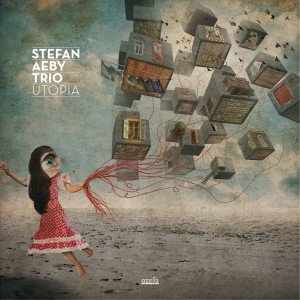 The Stefan Aeby Trio explores the possibilities of the jazz trio with its own Northern European, somewhat minimalist aesthetic. On Utopia, the trio’s second release, that aesthetic exhudes a wicked technical proficiency that is never flaunted for its own sake, but always remains secondary to the music itself. It flirts with an exploration of the “groove,” but never loses sight of jazz’s most important elements, the melody and the harmonies. This recording, thanks to the production of Aeby and Dagobert Böhm, and recording by Florian Pittet (not to mention the mixing and mastering) has lots of breathing room and a clear, clean sound that allows the performances to shine.
The Stefan Aeby Trio explores the possibilities of the jazz trio with its own Northern European, somewhat minimalist aesthetic. On Utopia, the trio’s second release, that aesthetic exhudes a wicked technical proficiency that is never flaunted for its own sake, but always remains secondary to the music itself. It flirts with an exploration of the “groove,” but never loses sight of jazz’s most important elements, the melody and the harmonies. This recording, thanks to the production of Aeby and Dagobert Böhm, and recording by Florian Pittet (not to mention the mixing and mastering) has lots of breathing room and a clear, clean sound that allows the performances to shine.
This young trio comprises pianist and composer Aeby and bassist André Pousaz, both of Germany, and Swiss drummer Michael “Michi” Stultz. They’re all university trained musicians with lots of field and road experience, which shows in the cool combination of sophistication and laid-back minimalism with which they play.
The highlight for me and one of my favorite tracks on any 2013 release is the lovely, melodic fourth track “Es schneit doch hüt,” a delightful bluesy take on a melody whose lineage sounds like it traces back to German art song via film soundtrack music. Bassist Pousaz really shines on this chance to play the melody and improvise around it. Here’s a video featuring this tune, whose title means something like “It’s snowing but hot.”
The next strongest track may be the opener “Vevey” (named for the Swiss home of Nestlé). Aeby’s right hand improvises a minimal melody that is stretched over a 5/4 frame and set to a line of descending related chords established by Aeby’s left hand and Pousaz’s bass. The whole thing rises to a dramatic crescendo, to which it is pushed steadily by Stulz’s driving percussive realizations.
But all of the eight offerings intrigue and delight in their own way. The title track features what sounds like an African talking drum and lots of other amazing percussion from Stulz and Aeby on prepared piano; “September” is brooding and mysterious, a meditative melody shared and swapped by bass and piano; the Cuban-inflected “Riot” sounds just like its title at the beginning, particularly its cacophonous wall of drumming and percussion, but it turns into a deep meditation on Latin jazz; both “Mingma” and “Bruine” hew relatively close to pre-fusion jazz with lots of casual improv from all three musicians on the former and a deep bass groove paired with rapid-fire spang-a-lang beat on the latter. The deeply meditative “Mindarai” with its long bass whole notes is, with Aeby’s increasingly intense playing, a suitable bookend and melancholy answer to “Vevey.”
The late great Bill Evans and his trios of course established the pattern for an ensemble in which all three players have a role in advancing the piece through melody, harmony and rhythm. It’s wonderful to see that tradition being carried forward with such vivacity by another generation of players.
Ozella, 2013
Stefan Aeby Trio has a website and they’re on Facebook.
